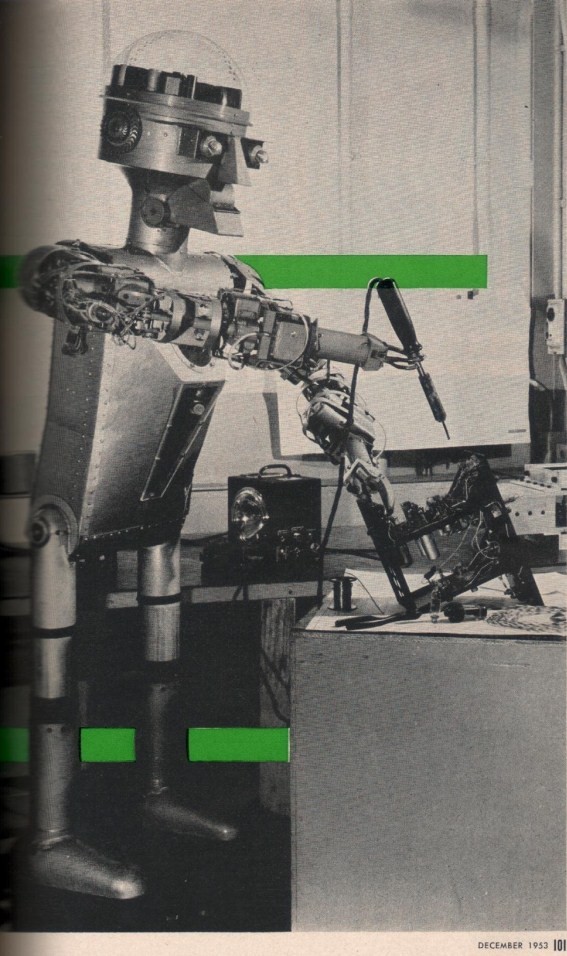
GARCO represents one of the first attempts at an all-purpose functional humanoid robot. Although he had most of his success as an entertainment robot, the inventor, Harvey Chapman Jr., believed he had other uses, such as "taking on a variety of tasks that would prove too dangerous for humans. Mixing the ingredients for TNT is one. If the stuff should blow up, you could install another robot and continue the job without much loss. Garco could work efficiently in a vacuum, in temperatures that would burn or freeze a man, handle radioactive elements without endangering anyone, or labor for hours on end under water." Its my guess that potential investors for industrial purposes didn't see through the humanoid form.
The control arm of the master-slave unit pre-dates the harness used by the Disney Imagineers for their Audio-Animatronics by 10 years. Were they inspired by what they saw back then?

See GARCO with Walt Disney at the start of this video clip here.
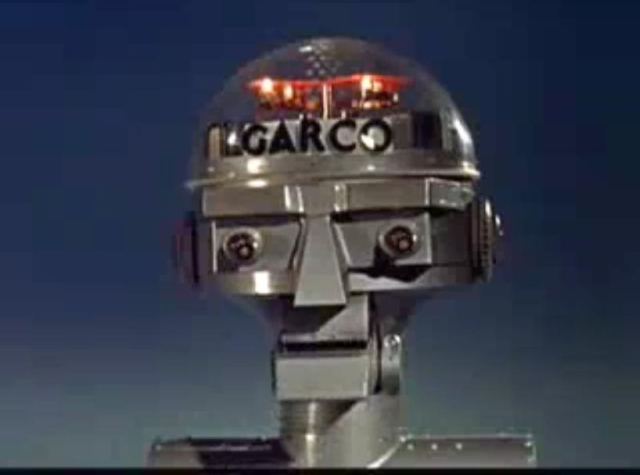

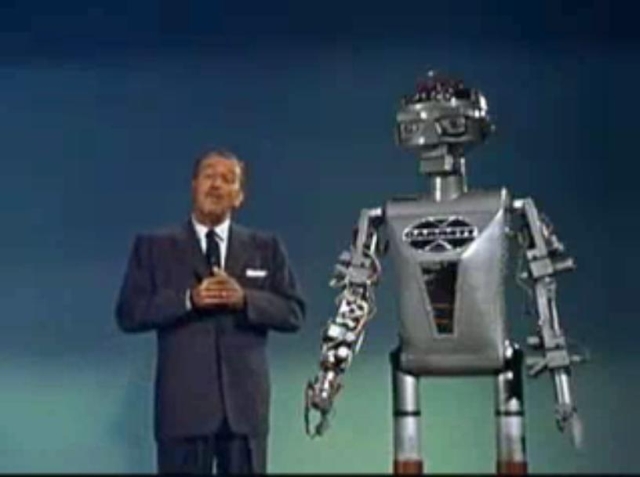
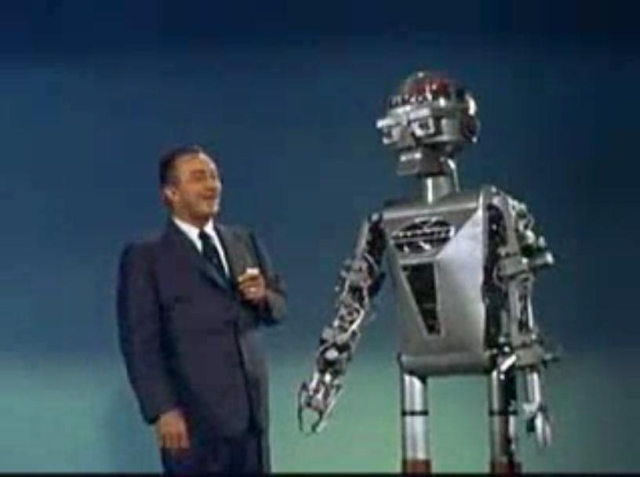
Whatever Happened to Walt’s Robot Friend, Garco?
Wednesday, July 2, 2008
Wade Sampson, staff writer, (Send an email)
While WALL-E may be the newest Disney robot enjoying his moment of celebrity, he is not the robot that stands out in my mind when I think of Disney. That honor belongs to Garco who shared the television screen briefly with Walt Disney himself in the late 1950s.I first saw Garco in a later rerun of the Disneyland television series, but apparently he was a celebrity robot during the 1950s. Just like some of today’s celebrity starlets, he was most famous for being famous and had a very limited range of talents but certainly took advantage of as many photo opportunities as he could.
Robots have been around since the days of classical mythology where Vulcan created mechanical servants. In approximately 1495, before he began work on “The Last Supper,” Leonardo Da Vinci designed and possibly built the first humanoid robot in Western civilization. This armored robot knight was designed to sit up, wave its arms, and move its head thanks to a flexible neck while opening and closing its anatomically correct jaw. Similar mechanical creations have popped up over the centuries to entertain and amaze audiences.
However, today we usually think of robots in terms of science fiction and outer space and Garco was very much a part of that culture.
Garco the robot was born in 1953. He was a natural publicity opportunity and would pop up in photos from stacking boxes in a warehouse to acting as a robot baseball umpire.
In June 1954, Garco was called into service as “Hollywood’s first mechanical press agent” for the recently released science fiction film Gog that featured a deadly robot going out of control at the climax of the film. According to a press release, “Garco, who represents a million dollars in electronic research, plans a personal appearance tour of the country in behalf of the movie.” If you browse the Internet, you can usually find a photo of Garco with starlet Sally Mansfield (who was a regular on the TV show Rocky Jones, Space Ranger) promoting the film. Garco is at a typewriter supposedly typing out a press release on a classic manual typewriter.
Science Fiction Theater was a ZIV-TV production of 78 episodes that were syndicated over NBC stations between April 1955 to February 1957 and then was rerun on various local affiliate stations. It was advertised as “stories of fiction from the borderlands of science.” The host was Truman Bradley and, in the episode “Time is Just a Place” by science-fiction director Jack Arnold (based on a story by Jack Finney), Garco popped up behind Bradley who was introducing the episode.
Not long afterward, Garco popped up with another television host on a much more popular television series.
Mars and Beyond (December 4, 1957) was the last of a trilogy of films directed by Ward Kimball for the “Tomorrowland” segment of the Disneyland television show on ABC. Garco introduces Walt Disney and they joke a bit before the episode that is primarily an animated history of mankind’s fascination with outer space, especially the planet Mars, as well a more serious exploration about the possibility of journeying to the red planet.
The animation of wild speculation of possible Martian creatures led Walt Disney to proclaim to director Kimball, “How do you guys come up with all these crazy ideas?”
Walt never seemed to be a fan of science fiction but he loved science fact and the futuristic speculation that revolved around those facts. In the 1950s, he wanted Tomorrowland at Disneyland to be “science factual” which is why he didn’t include UFOs and little green men. Walt was also fascinated by mechanical things and I wonder how much Garco might have excited Walt about the possibility of Audio-Animatronics.
Since legendary voice artist Paul Frees was the narrator of the episode, I often wondered if he also provided the voice for “Garco” for this segment.
This classic episode (along with the rest of the trilogy) is available on the DVD Walt Disney Treasures – Tomorrowland: Disney in Space and Beyond.
You can check out a picture of Walt and Garco here, then spend a little more time exploring Jeff Pepper’s entertaining and accurate Web site devoted to Disney oddities.
But was the origin of Garco and how did he work?
Garco was built in 1953 by Harvey Chapman, an engineer for the Garrett Supply Company of Los Angeles (which explains the “Garrett” name plate on the front of Garco on the Disneyland TV show) in three months in his home garage out of discarded airplane parts.
Although Garco started out as a publicity stunt, like many of the other so-called mechanical men that appeared in the two decades before Garco, Chapman, when he was interviewed by Popular Science magazine for its December 1953 issue, felt that his creation should be taken more seriously.
Garco’s brain was electronic using six aircraft servo systems. His nervous system consisted of 1,200 feet of wire cable. A two-way radio transmitter enabled Garco to make pertinent remarks.
Chapman felt that creations like Garco could be utilized to do a lot of the highly dangerous but necessary jobs like mixing the ingredients for experimental explosives, handle deadly bacteria, weld, handle radioactive material, salvage items from underwater and perhaps even pilot the first rocket to the moon.
According to the article: “Chapman brings Garco to apparent life by first opening the circuits and sending electricity surging into the complex metal body. He then lays his right arm along a five-jointed electromechanical control arm, which has a handgrip at the end of it. The joints can be moved up and down, in and out. As Chapman twists and turns his own arm—and the control arm along with it—Garco’s right arm moves in exactly the same way. Garco is so sensitive, in fact, that if Chapman’s hand shakes, Garco’s does, too.”
To me, this sounds very similar to the control harness Imagineer Wathel Rogers demonstrated for the early Audio-Animatronics for the Carousel of Progress.
“As the joints in the control arm move through six electric channels they notify sensing devices in Garco’s electronic brain that they have disturbed the balance in many Wheatstone-bridge systems. The disturbance of each fires an electronic tube, which in turn fires a relay tube, which actuates one of the five [actually .05-RH] horsepower motors in Garco’s right arm. So much for the right arm, Garco’s left is manipulated by 22 push buttons, mounted on the case of the control arm. The push buttons, in addition to working Garco’s left hand and arm, move the robot’s jaws and lips, increase his height six inches, roll his plastic eyes and enable him to bow at the hips.
“Both of Garco’s arms contain five tiny actuator motors. Three apply torque, representing the ball joints of a man’s shoulder and elbow; the others, taking the place of tendons, apply linear push and pull.”
Many mysteries still surround Garco. Why was he named “Garco”? Did each letter stand for something? Whatever happened to Garco? He seems to disappear from the publicity circuit in the 1960s perhaps replaced by more modern counterparts like Robby the Robot.
To me, it is a joy seeing Walt interact playfully with Garco, something that is even more apparent in the behind-the-scenes publicity photos where Walt even spars with the mechanical man. Will WALL-E be remembered in another half-century or like Garco will he be just another example of a forgotten "Future Past"?Wade Sampson grew up in the Los Angeles area and since the age of five was a frequent visitor to Disneyland. He was an original member of both the Mouse Club and the National Fantasy Fan Club. He attended all the local conventions where he had the opportunity to interview many of the people who actually worked with Walt Disney. Wade describes his house as looking like "a toy shop and a bookstore exploded and I decided to live in the remains". For over two decades, he has been a freelance writer and a teacher and for a while was a dealer in animation artwork and related resources. His columns concentrate on sharing stories of Disney history that haven't been recorded elsewhere.
The Los Angeles Times on Aug 6, 1961 reported that "Garco Shows Signs of Wear, Will Retire – A mechanical man who can play chess, mix drinks, hammer nails and carry out other assignments with human encouragement will retire from active duty soon."
Paleofuture [Dec 2010] has located a more detailed article on the "retirement" of GARCO. I've included it here.
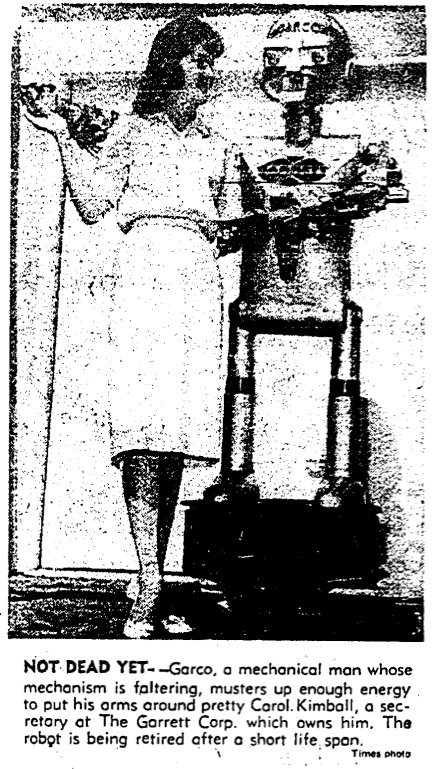
Los Angeles Times July 31, 1961 .
Garco Shows Signs of Wear, Will Retire
A mechanical man who can play chess, mix drinks, hammer nails and carry out other assignments with human encouragement will retire from active duty soon.
His mechanism is breaking down. The Garrett Corp. owns the robot.
"We are hoping to find a permanent home for him in the Smithsonian Institute or some other museum where he can be preserved for posterity," said Mickey Parr, a company spokesman.
Active Robot
Workers who built him eight years ago with surplus aircraft parts call him "Garco." They contend he has had more activity in his short lifetime than the average man sees in a span of 70 years.
Since 1953 Garco has taken part in several motion pictures, television shows, commercials and appeared at numerous charity events.
Delicate Child
But from the start Garco proved to be a delicate child. His problems arose from mechanical sickness, often causing his operating system to break down. As a result, the company always kept an engineer assigned to Garco. The engineer in charge of the mechanical man would keep Garco in his garage at home.
Mechanical Doctoring
Presently, Garco is receiving mechanical doctoring from Gary Rollo, 5308 Clearsight St.
"I've had a lot of fun working on him," Rollo said, "and at times I wonder if he isn't really human. He certainly acts more intelligently than some people I know."
Garco press photo 1954.
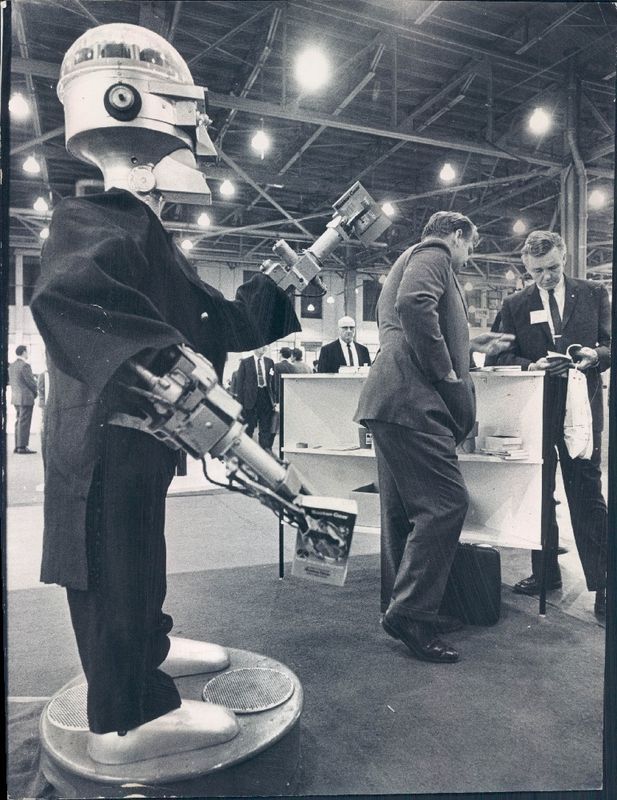
Garco may have been around longer still. This article from 'Daily News' May 18, 1970.
He packs a big punch. The gears, levers and electrical-drive systems that Boston Gear Co. manufacturers are displayed in Boston, the Mechanical Man, company mascot. Bosto, who was on display at the Design Engineering Show at the International Amphitheater, is operated by remote control. (Photo by Charles Krejesi).
Walt Disney with GARCO
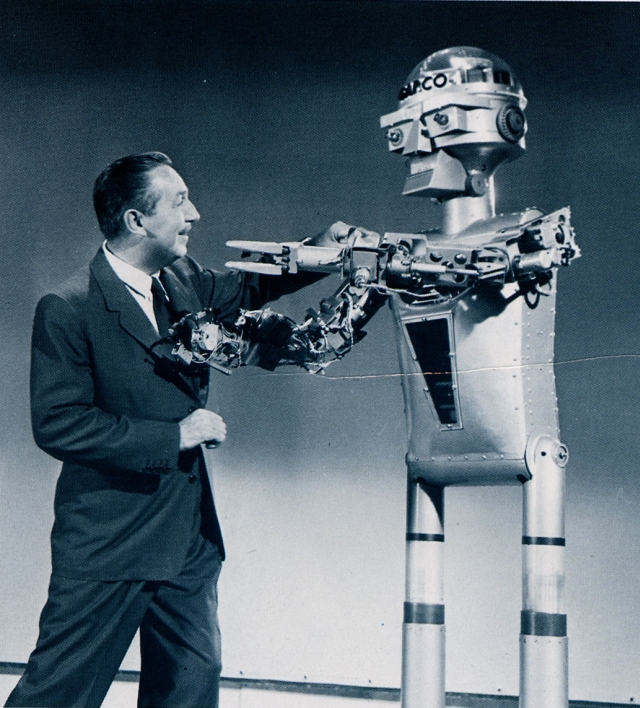
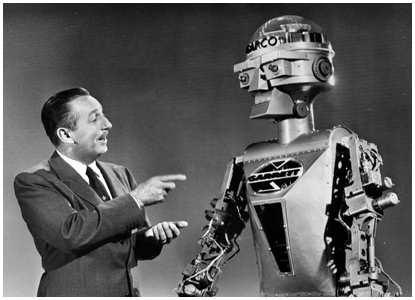
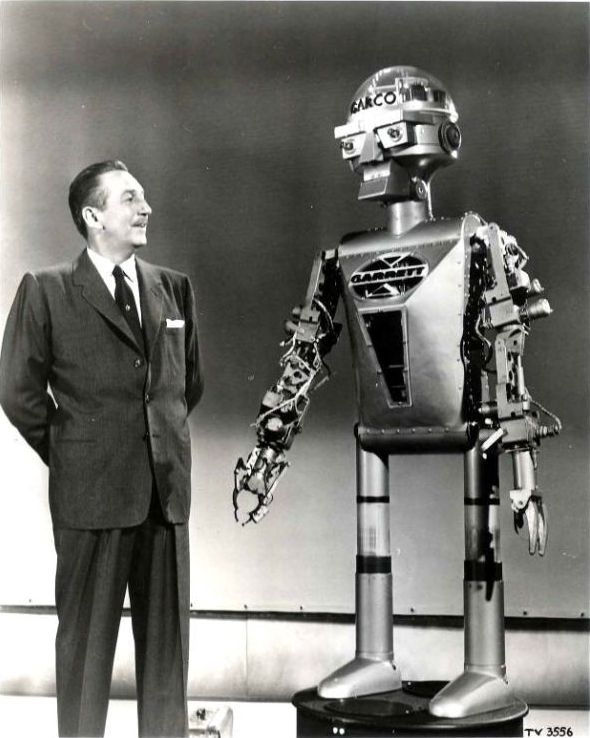
The control arm of the master-slave unit pre-dates the harness used by the Disney Imagineers for their Audio-Animatronics by 10 years. Were they inspired by what they saw back then in MARS AND BEYOND (DISNEY, 1957)?
Mars & Beyond is an episode of Disneyland (The History and Future of Man and Space) which aired on December 4, 1957. It was directed by Ward Kimball & narrated by Paul Frees. This episode discusses the possibility of life on other planets, especially Mars. It begins with an introduction of Walt Disney & his robot friend Garco, who provide a brief overview.
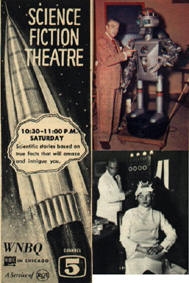
Science Fiction Theater was a ZIV-TV production of 78 episodes that were syndicated over NBC stations between April 1955 to February 1957 and then was rerun on various local affiliate stations. It was advertised as “stories of fiction from the borderlands of science.” The host was Truman Bradley and, in the episode “Time is Just a Place” by science-fiction director Jack Arnold (based on a story by Jack Finney), Garco popped up behind Bradley who was introducing the episode.
Science Fiction Theater – segments from a COLOR… by videohollic
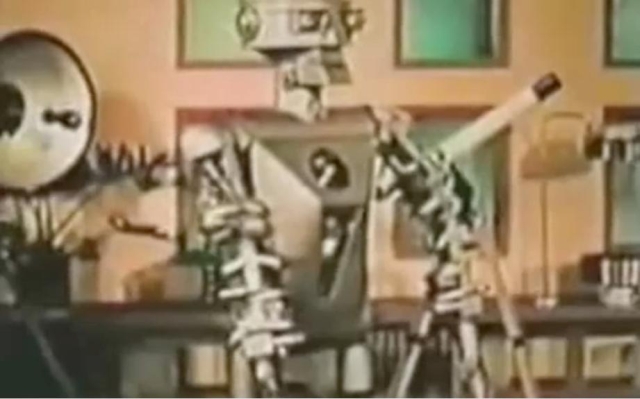
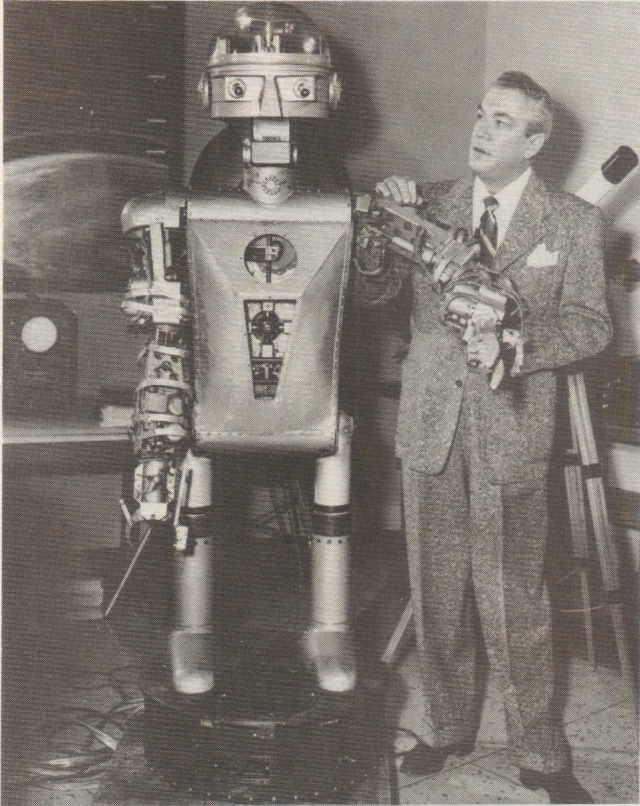
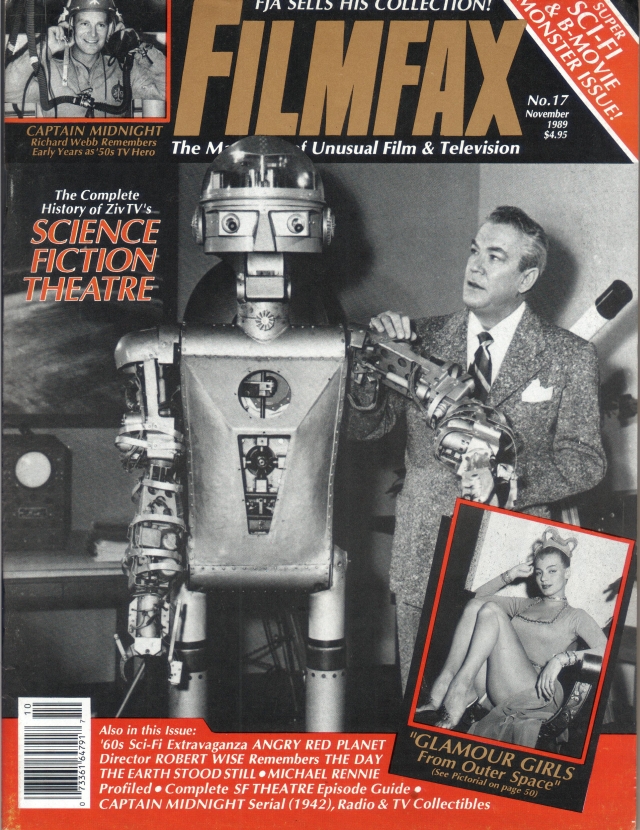
Trueman Bradley (of "Science Fiction Theatre" fame) with GARCO on the cover of FILMFAX #17 Nov 1989.
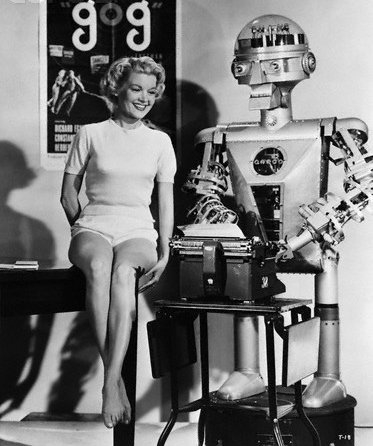
Promotional work for the Sci-Fi movie called "Gog" (1954) about robots . Here he is with Sally Mansfield.


The poster depiction of Gog more like Garco than Gog itself.

Garco holding a doll – not quite the same as holding the leading star as depicted in the poster!
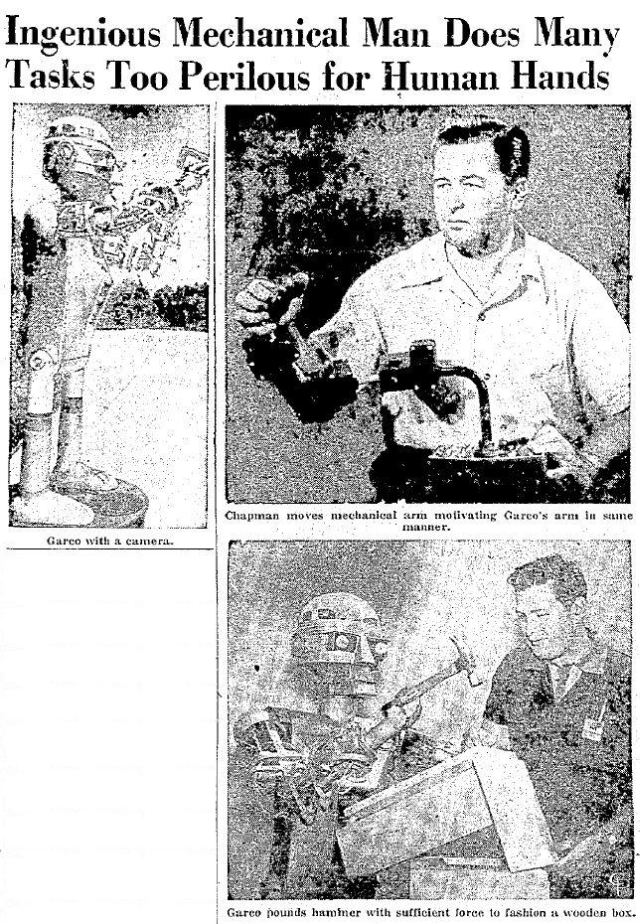
GARCO showing his hammering skills. He must have had a good grip on the handle plus reasonable dexterity without too much lag for it to be effective. Pity we don't have film footage of this particular action.
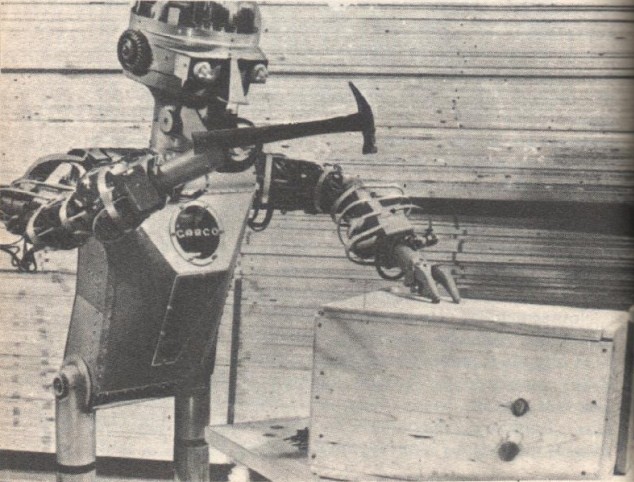
….still hammering….
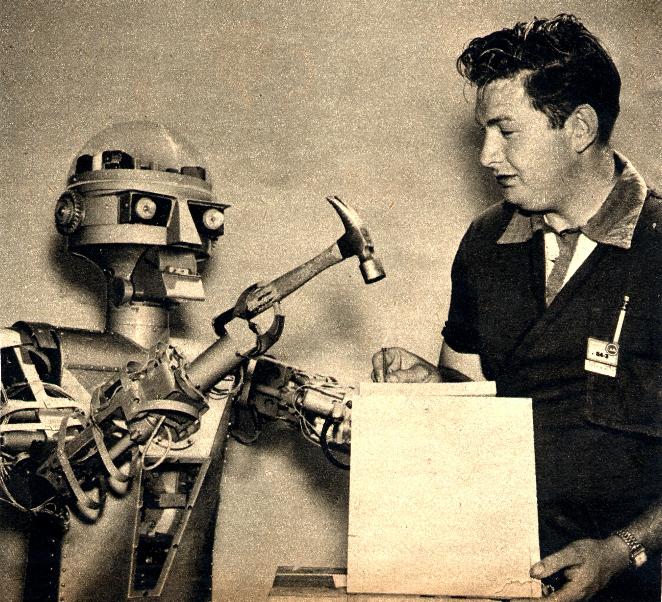
…nearly finished….

Newark Advocate 11 May 1954 p11
LOS ANGELES — Harvey Chapman invited a group of neighborhood kids into his back yard the other day. They stared pop-eyed, at what they witnessed.
A mechanical man turned, bowed and stared right back. The creation resembled nothing they ever had seen, except maybe on television or in the movies.
"Gosh!" exclaimed one of the more venturesome visitors."It's a space man with his, insides showing."
Chapman has devised one of the most ingenious, mechanical men ever created. It can drive a nail through a. board.It can wield a saw and slice a board in two, neat as you please. It can handle a drill and bore holes.
It can even play checkers. However, there's a gimmick of course.Named By Creator
The man, called by its creator "Garco," for the Garret company, for which Chapman is an engineer, duplicates, precisely and accurately, its operator's motions. Garco is an electronic man. That means, electrical circuits cause him to move his body, head and arms. To start Garco going, Chapman opens the electrical circuits, sending.
electricity surging through the complete metal body. Chapman lays his right arm along an electromechanical counterpart of Garco's right arm'. As Chapman bends his arm, the robot's right arm twists and turns.
It's a miracle of electronics that makes the robot move. Five joints in the control arm move. Through several electronic channels the movements notify sensing devices in the "brain." The sensing devices in turn cause electric motors in the arm to move in the required directions.
A total of 22 buttons control the left hand, arm joints, jaw and lip, and eyes. Vacuum applied to rubber-tipped fingers of the left hand cause this hand to pick up small objects.Made From Junk
You'd think this mechanical marvel cost a good many dollars to construct. Not so. Chapman built Garco from junk parts, mostly motors and whatnot salvaged from airplanes.
What can Garco do? Chapman prefers to say that mechanical men, including this one, can take on a variety of tasks that would prove too dangerous for humans. Mixing the ingredients for TNT is one. If the stuff should blow up, you could install another robot and continue the job without much loss. Garco could work efficiently in a vacuum, in temperatures that would burn or freeze a man, handle radioactive elements without endangering anyone, or labor for hours on end under water.
Chapman built Garco during 45 days and nights of intensive work. Although the monster cost considerably less than $1,000 for materials, you couldn't buy it for several times that sum.
"What father," asks Chapman, "would put his own child on the auction block?"
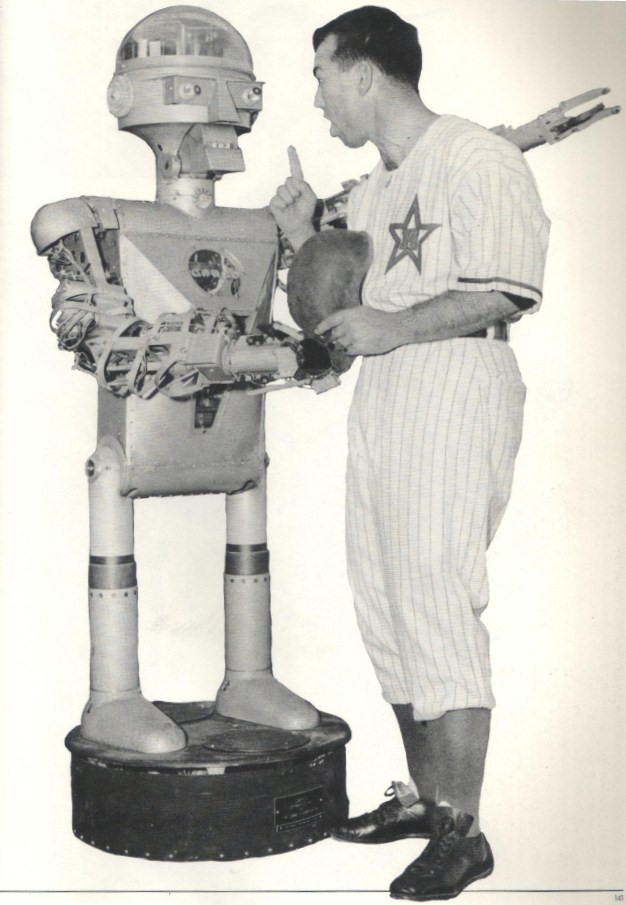
Above image from Jasia Reichardt's book "Robots: Fact, Fiction, and Prediction".
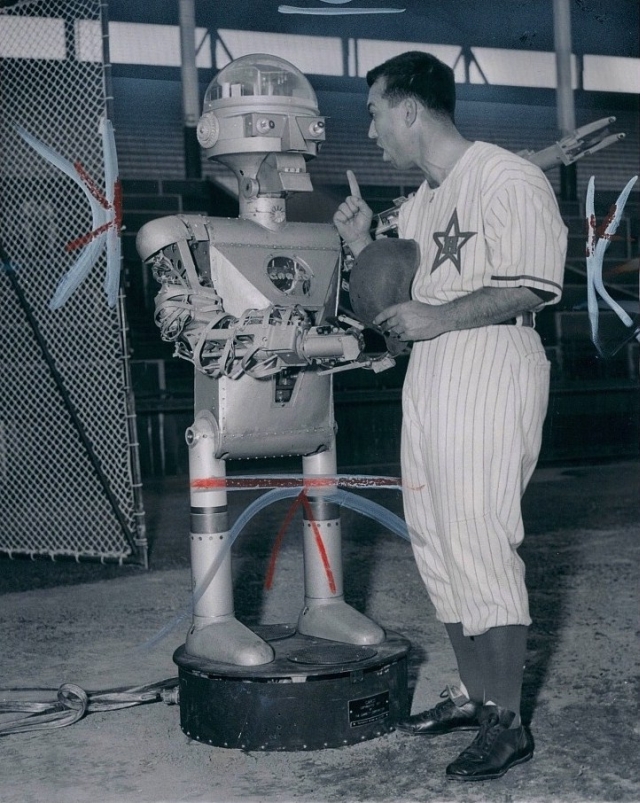
19 Jan 1966
"Wasted Words"
Manager Bobby Bragan of the Hollywood Stars finds the umpire literally deaf to argument during pre-game practice of his team in Hollywood, Calif. The umpire is Garco, an electronic robot who ordered Bragan to leave the game, and took no back talk. Garco, whose activities are varied and seem almost human at times, is moved by the same type of automatic controls as those produced by his maker for the aircraft industry.
Patent number: D171439 (see pdf here)
Filing date: Oct 20, 1953
Issue date: Feb 1954

The GARCO figure showing sleeved arms.

Patent number: 2858947 (see pdf here)
Filing date: Nov 16, 1953
Issue date: Nov 1958
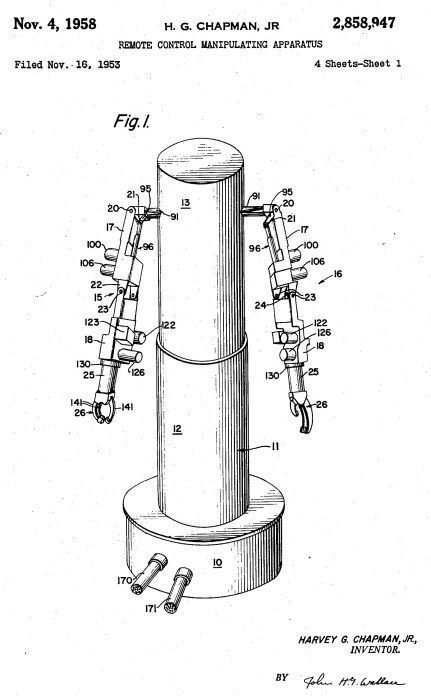

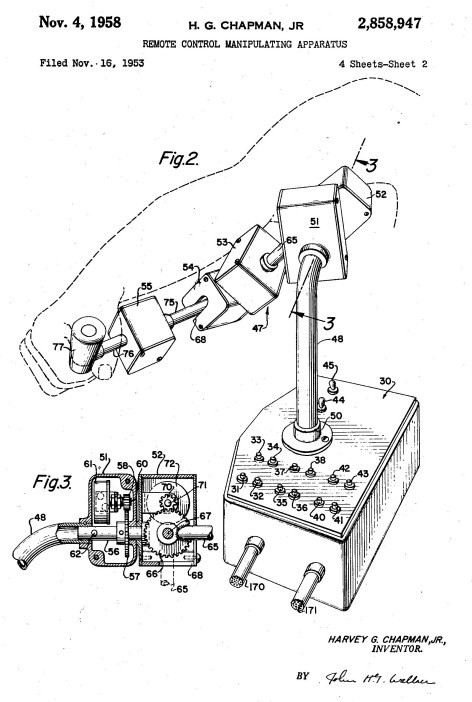

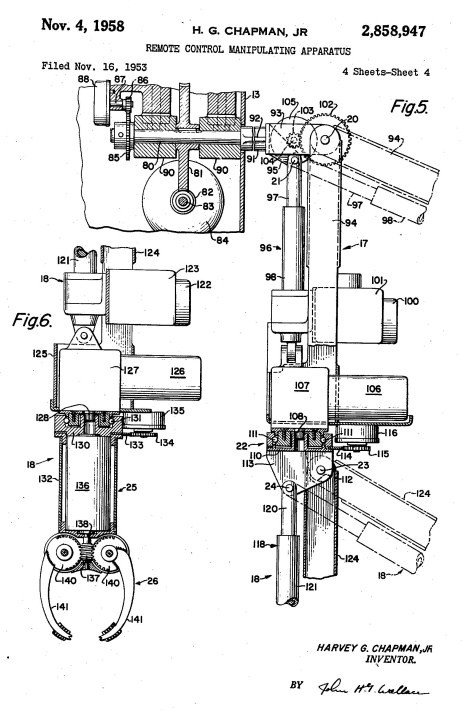
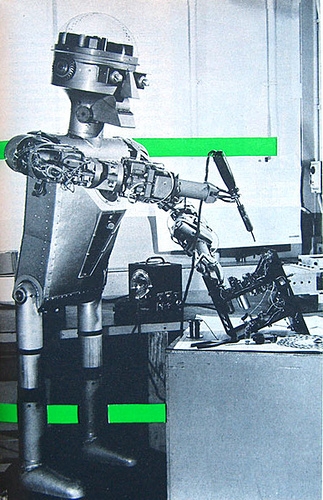
Popular Science December 1953
Plug-In Workman Built in 90 Days
Garco, newest in a long line of man-made men, can do homely tasks now but is cut out for more dangerous duties.
By Andrew R. Boone
GARCO, a mechanical man recently "born" in a California garage, can saw, hammer, drill, mix chemicals, pick up papers, stack boxes, roll his eyes and have the shakes. He can also play chess.
In this last accomplishment he resembles a sensational robot of about 200 years ago. That celebrated member of the ancient mechanical family, dressed like a Turk, was the rage of Europe. He played chess with Catherine the Great,Frederick the Great, Benjamin Franklin and Napoleon. He even had the temerity to sweep the board clean after Napoleon had made three wrong moves. Years after these worthies were dead and gone, some bright-eyed boys discovered that a small, skinny, unmistakably human man hid out in the boxlike chest under the chessboard and worked the levers that made the "mechanical" man seem so clever.
Made of Discarded Plane Parts, Garco, latest in a distinguished line of man-made men, is a lot cleverer than thisfraudulent Turk, but he needs human direction, too. He gets it, through a control arm and push buttons, from Harvey Chapman, an engineer for the Garrett Supply Co. of Los Angeles, Calif. Chapman created Garco in three months, in his garage. The 90-day wonder was put together and made animate with discarded airplane parts.
Garco is a well-oiled creature of Convair gear trains, Constellation electrical actuators, and DC-6 cabin-pressure regulators, plus electronic circuits and enough sheet metal to make him decent. With the aid of a vacuum applied through his rubber-tipped fingers, he can pick up light objects with commendable delicacy. His brain is electronic, a neat accumulation of six aircraft servo systems. His nervous system consists of 1,200 feet of wire cable. A two-way radio transmitter enables him to make pertinent remarks.
Chapman brings Garco to apparent life by first opening the circuits and sending electricity surging into the complex metal body. He then lays his right arm along a five-jointed electromechanical control arm, which has a handgrip at the end of it. The joints can be moved up and down, in and out. As Chapman twists and turns his own arm—and the control arm along with it—Garco's right arm moves in exactly the same way. Garco is so sensitive, in fact, that if Chapman's hand shakes, Garco's does, too.
Electronic Miracle
What happens is a minor miracle of electronics.
As the joints in the control arm move. through six electric channels they notify sensing devices in Garco's electronic brain that they have disturbed the balance in as many Wheatstone-bridge systems. The disturbance of each fires an electronic tube, which in turn fires a relay tube, which actuates one of the five .05-horsepower motors in Garco's right arm.
So much for the right arm. Garco's left is manipulated by 22 push buttons, mounted on the case of the control arm.
The push buttons, in addition to working Garco's left hand and arm, move the robot's jaws and lips, increase his height six inches, roll his plastic eyes and enable him to bow at the hips.
Both of Garco's arms contain five tiny actuator motors. Three apply torque, representing the ball joints of a man's shoulder and elbow; the others, taking the place of tendons, apply linear push and pull.
Most of the mechanical men of history—and they go all the way back to Daedalus, who, if we can believe Plato, created statues that had to be tied down to be kept from running away—have been built as stunts.
About the only exception was a fabulous man of clay that Albertus Magnus, back in the thirteenth century, spent 30 years putting together. When he got through with it, the creature supposedly was able to walk, talk, answer questions intelligently and solve problems. But Thomas Aquinas, a pupil of Magnus and a youth with a wholesome fear of the Devil, attributed the clay man's gifts to the Evil One, and smashed it.
Magnus apparently was a man of awesome self-restraint. All he is reported to have said was, "There goes the work of 30 years!" But he said it in Latin, and the report may have gotten garbled.
Almost all other recorded mechanical men have been built to amuse and amaze the public and, directly or indirectly, make money for their creators.
Robots for Science
In recent years, however, some have been built for scientific purposes.
General Electric, for example, developed an electromechanical head for testing oxygen masks at sub-zero temperatures, and a mechanical hand for fiddling with "hot" materials at Hanford and other AEC plants.
What's the justification for Garco? Well, he started out as a 'stunt, too. But Chapman thinks he should be taken a lot more seriously than that.
Why not, he asks, use creatures like Garco to do a lot of the highly dangerous but necessary jobs that more perishable men now do? For instance: mix the ingredients for experimental explosives, handle deadly bacteria and fungi, weld and salvage under water.
Robots of Garco's stripe, Chapman. suggests, could also braze titanium in a vacuum, work under any degree of atmospheric pressure, handle radioactive stuff—even pilot the first rocket to the moon. END
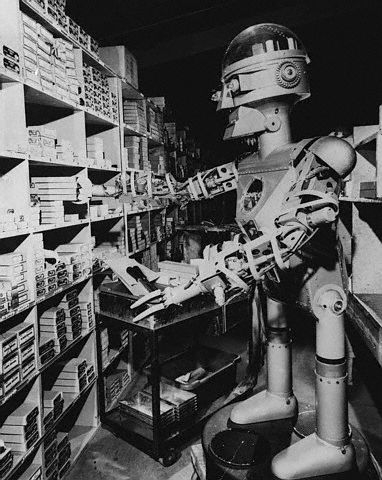
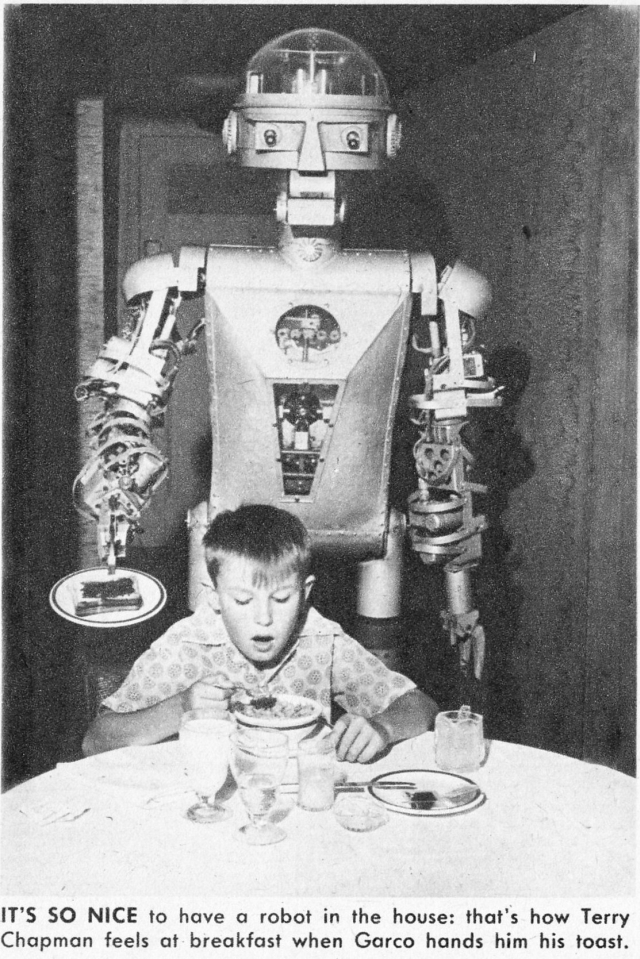
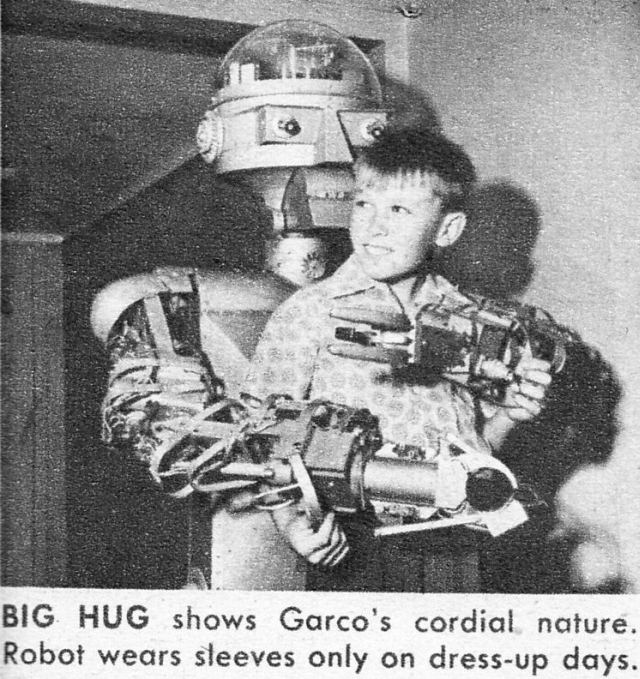
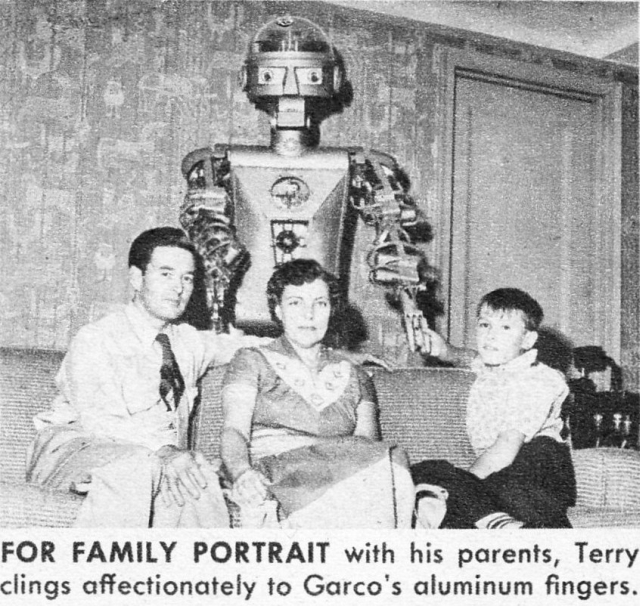
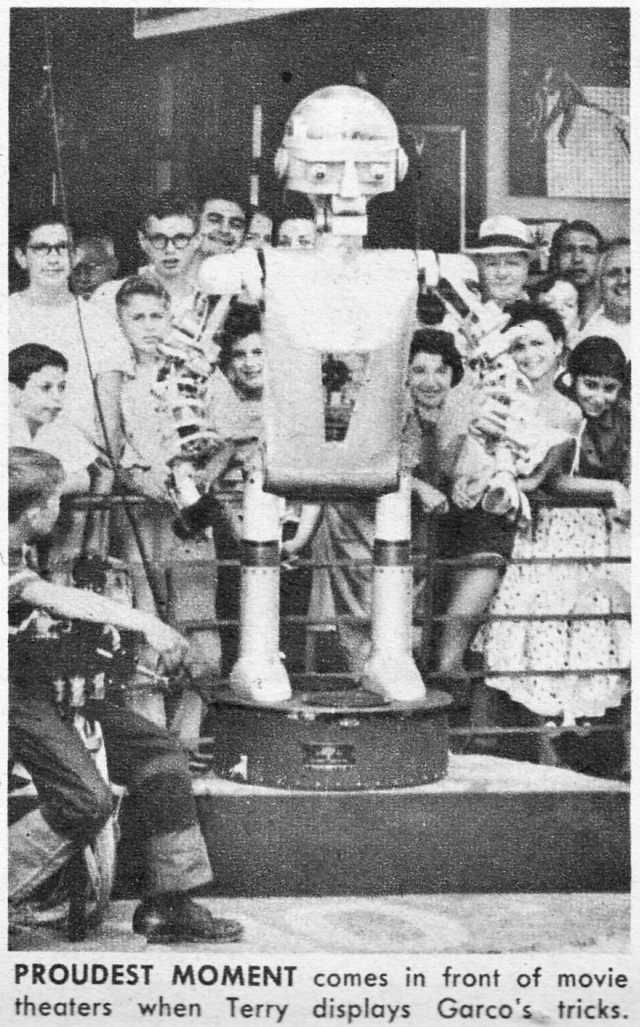
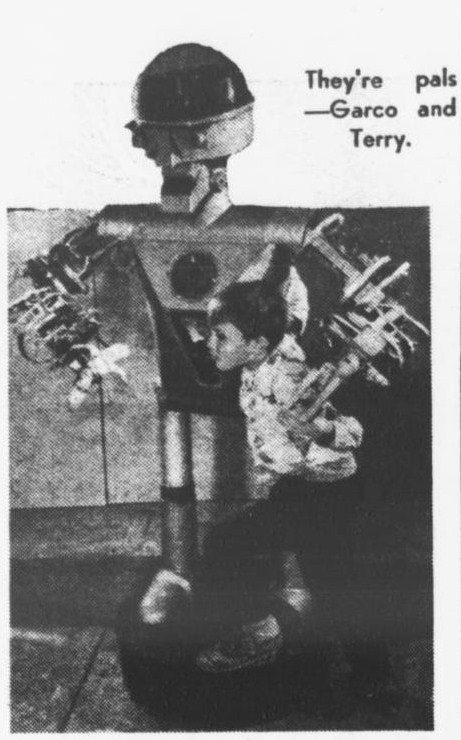
Oakland Tribune17 Oct 1954 p278-9
A Robot in the Family
by KAY SULLIVAN
All the kids envy young Terry Chapman:
he lives with a mechanical monsterCLENDALE, CALIF.
ELEVEN-YEAR-OLD Terry Chapman thinks he is the luckiest boy in the world. "Other kids have to look at television or go to the movies to see a robot," he says. "I've got one right in the family!" Terry is referring to Garco, a towering mechanical man that his dad, engineer Harvey Chapman, built a year ago. Garco was created out of used aircraft parts for the Garrett Manufacturing Corp. (hence his name) for display at a metals exhibition. He proved to be such a fascinating fellow that the Chapmans kept him around. In fact, Garco has taken over the Chapman household.
"Garco is in such demand for personal appearances, TV shows and-factory demonstrations that we find ourselves adjusting our schedules to his," says Mr. Chapman. Garco just wound up a tour of U.S. theaters in conjunction with Gog (United Artists), a movie about robots. "But Gog is a killer," Terry emphasizes. "Our Garco wouldn't hurt anybody. He's a good robot." Terry has been devoted to the monster ever since his father started to build him. "Terry haunted the workshop while Garco was being born," says Mr. Chapman. "He talked a blue streak, telling me just what he wanted the robot to do. If he had his way, Garco would be able to ride a bicycle across a tightrope." As it is, Garco can do plenty—and young Terry puts him through his paces with as much skill as the senior Chapman. During the cross-country theater tour, Terry operated Garco and answered questions flung at him by throngs of youngsters and adults. "What bothered me most was the silly questions some people asked," says Terry. "I'd be telling them all about his electronic brain cells and they'd want to know what he eats. Or could he dance!" Terry's biggest delight was making Garco's arms go up, his eyes goggle and his teeth chatter. That always made the girls squeal, he recalls.
Garco weighs 235 pounds and stands 5'8". Terry, who is a lean 80 pounds and a shade under 5', refers to him as "The Big Boy." He has great respect for him.A Choice of Hands
"GARCO HAS two different kinds of arms and hands," Terry explains. "An automatic right arm run by remote control and a push-button left arm. His right hand has vacuum cups on each finger to hold things and his left hand is a steel claw. What a grip he has!"
Garco also can telescope his legs and grow six inches taller. Terry points out that this is handy for reaching up to high shelves. A mannerly fellow, Garco bows from the waist at appropriate moments. Once, someone pushed a button unexpectedly and Garco bowed too far forward and toppled over. His bubble head came off, his nose was smashed and his jaw broken. Terry was filled with sympathy. "Gosh, I wish it had happened to me," he told his mother, "It would be a lot easier to patch me up."
Fortunately, Mr. Chapman was able to repair the robot and only a dent in his aluminum nose remains to remind Terry of that fearful day. At the Chapman home here, Garco is kept out m the workshop and Terry has set up regular after-school "visiting hours" when his classmates can come over and see Garco. "They all think he's keen-o," says Terry. Mr. Chapman confirms this impression "In one week I had something like 22 requests from young gentlemen to build them a robot," he says. "This could be a lifetime career Garco, incidentally, is insured for $10,000.To reproduce him would cost some $40,000 for labor and parts. There is one other working mechanical man in existence—Electro[sic], owned by Westinghouse. “Electro[sic] was in Los Angeles at a home show," says Terry gleefully, "and you know what I did? Stuck a card on his chest saying 'Garco was here!'" Terry helps his father keep Garco in good running order, helps oil him, dust him, slip a plastic "nightshirt" over him to keep off the dust. He's very concerned with "The Big Boy's" appearance, gets especially upset when his dad doesn't "button Garco's coat on thoroughly."
It seems there are some 200 small screws holding front and back aluminum plates on the robot. They have to be removed frequently so Mr. Chapman can check the inner mechanism. To save time, he sometimes replaces only every third screw. This is when Terry starts worrying "Gee, Dad, what will people say?" he asks. "They'll think Garco is a sloppy dresser!"
GARCO from Honeywell Archives
What Can You Do With Salvaged Aircraft Parts? Build A Robot, Of Course
7/10/2014
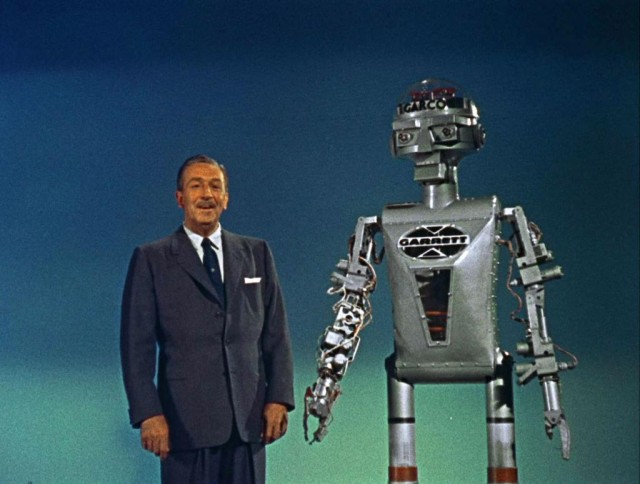
Robots are dominating the online conversation nowadays. I was with my family, watching a NASA video that Honeywell shared a few weeks ago, and my toddler found a new favorite word (although it sounds more like “wobot”).
Imagine my surprise when I was thumbing through a collection of mid-1950s articles from Honeywell legacy company Garrett Airesearch and found a picture of an actual robot, amongst images of vintage airplane parts.
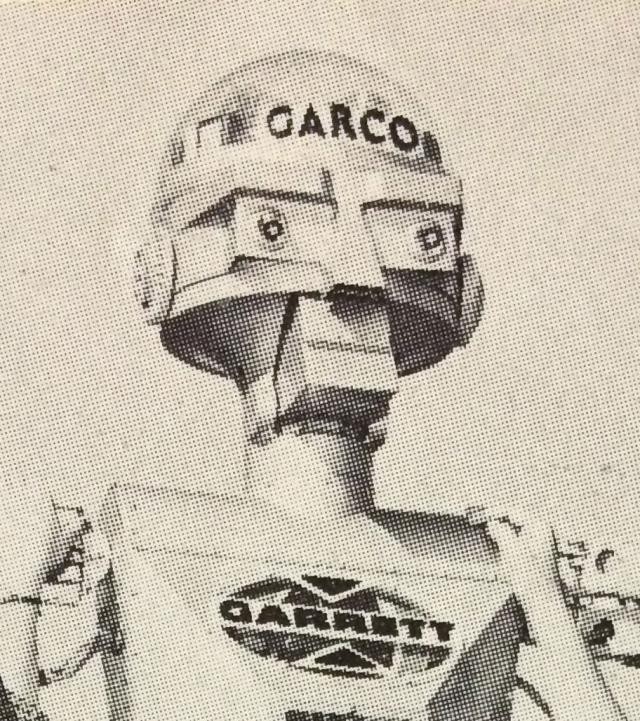
Just “plane” cool
A Garrett Airesearch electrical engineer led the design and construction of the robot, built in 90 days from discarded lab test equipment and salvaged plane parts to demonstrate the company's versatility of industrial products. These were not just any plane parts: Gear trains for Convair, cabin pressure regulators for the DC-6 and electrical actuators for the Constellation. According to an article in Popular Science magazine, the robot’s brain was made of six aircraft servo systems.
His name? “Garco,” derived from The Garrett Corporation. More facts about Garco:
• Weighed about 250 pounds and stood 5 1/2 feet tall on a pedestal fitted to rotate
• Made up of 60 wire connections, incorporating over 1200 feet of wire cable
• Bowing, nodding, opening and closing mouth, rotating eyes and human-like arms made this robot functional
• Garco's left hand had suction cups on the finger tips, while the right hand looked like a claw
• Considered a "loyal employee" of Garrett Airesearch, Garco appeared at industry trade shows

March 1955: Garco "studies" a catalog of Garrett products in preparation for appearance at the Western Metals Exposition.
Garco the Celebri-bot
As popularity grew, Garco didn’t stay behind closed doors. He was actually a bit of a celebrity in his day, making appearances at more than just trade shows. Garco appeared at charity events, in magazines, variety shows, and (my personal favorite) on Walt Disney’s “Disneyland” TV series.
“Garco introduced and appeared with Walt Disney in the lead-in to Mars and Beyond, a ‘science factual’ program that first aired on the Disneyland television series on December 4, 1957,” said Steven Vagnini, archivist for the Walt Disney Company. The irony? As you may know, Honeywell navigation and guidance technologies contributed to the success of NASA's Mars Science Laboratory and landing its Curiosity Rover land on Mars in 2012.
Footage from MARS AND BEYOND Courtesy of Disney Enterprises, Inc.
But Garco left a lasting impression on Disney. “The appearance was so memorable that footage and photographs of that moment have been showcased at [some] Disney parks, including at Walt Disney World Resort (Sci-Fi Dine In-Theater Restaurant at Disney’s Hollywood Studios and previously at Space Mountain at Magic Kingdom Park) and at Disneyland Resort (Innoventions at Disneyland Park),” Vagnini shared.
Ahead of the times
A true innovation with “more activity in his… lifetime than the average man sees in… 70 years,” Garco disappeared from public “life” in the 1960s. He was rumored to be seen at Honeywell’s site in Torrance, California in the past decade, but his current whereabouts are unknown.
We’re just happy to have pictures and video of the aviation-fueled Garco in his prime. Enjoy the photos below!
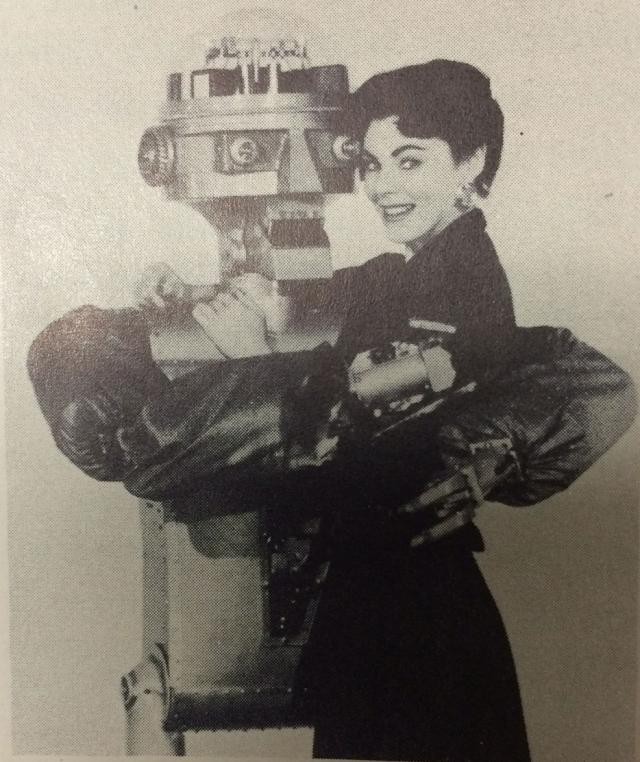
Star-Struck! Garco poses with Hollywood actress Joanne Gilbert in this photo from early 1954.
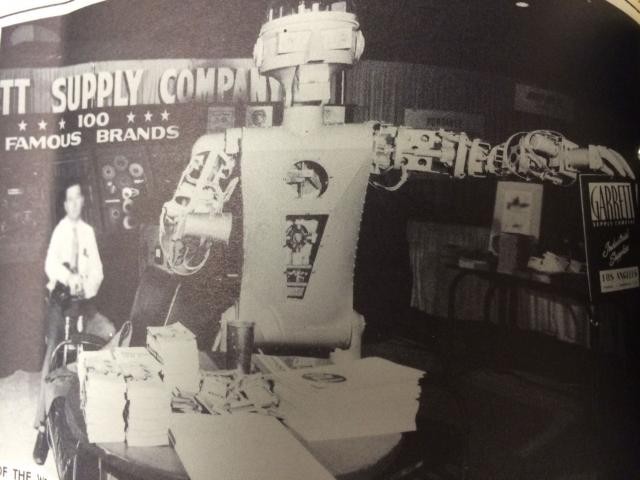
Garco is seen in this 1953 picture at the Western Metals Exposition. He's pouring himself a drink (of oil).

The robot was challenged on the Dave Garroway television show to play the celesta. The original photo's caption, from May 1959, also notes that Garco made an appearance on the Dick Clark Show.
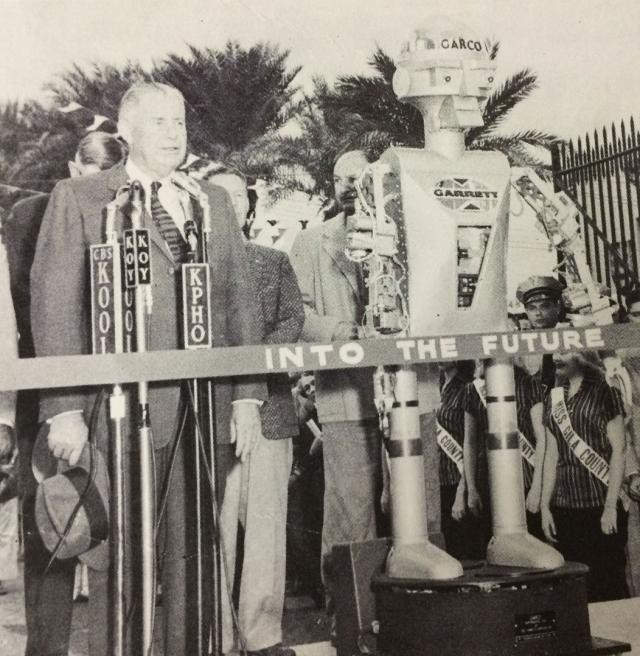
Garco cut the ribbon at the "Into The Future"-themed Arizona State Fair in November 1957. The robot was also on display at the fair.
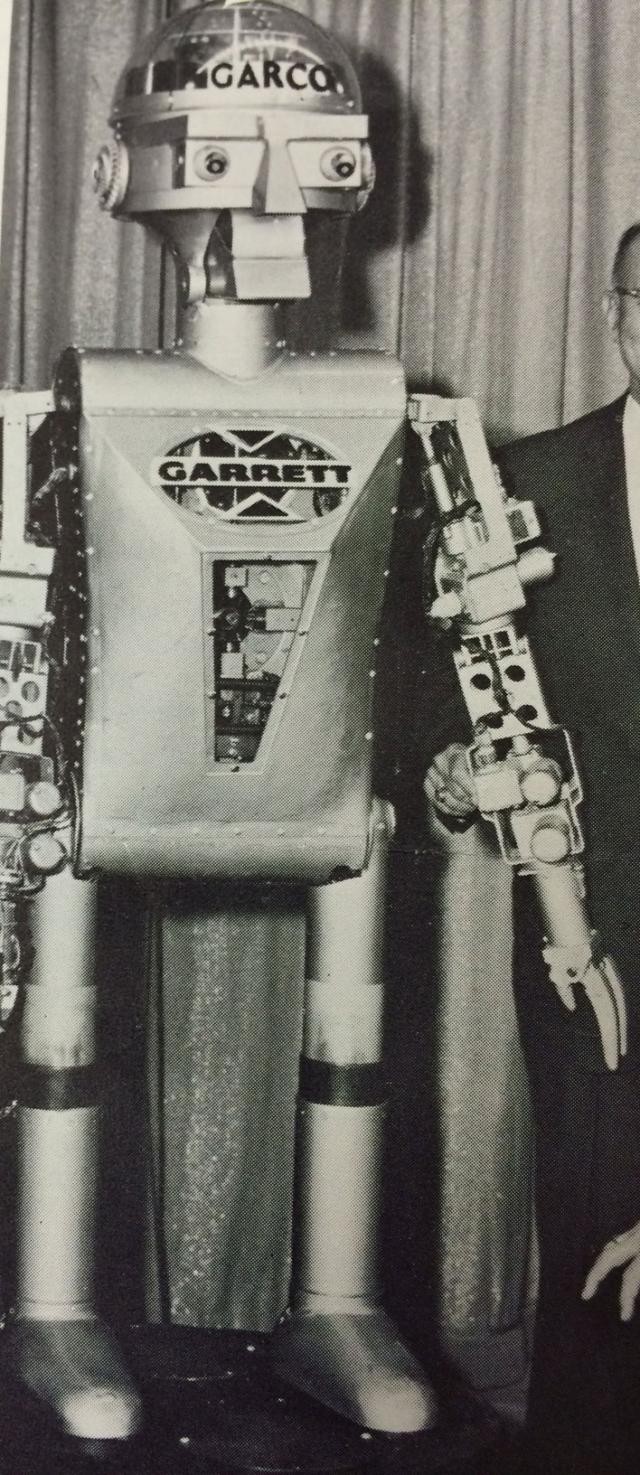
Garco appeared on Jack Bailey's "Queen for a Day" television show in 1959-1960.
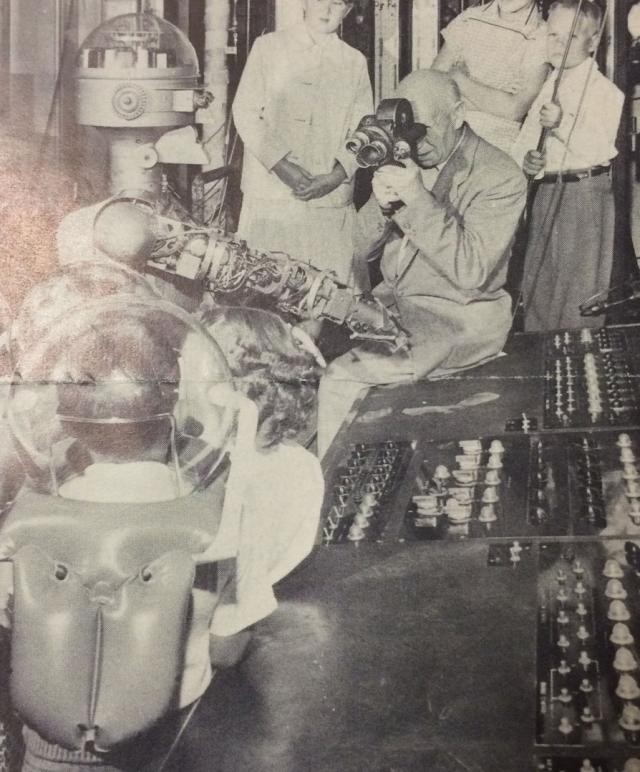
Garco with employees' children in Garrett Airesearch's altitude lab. Garco, being filmed for a television segment, operated the control panel.
Author: Farzana Scofield
Farzana Scofield is a Social Media Specialist with Honeywell Aerospace. She joined the Honeywell team in July 2013. Farzana holds a bachelor of arts degree in communication from Arizona State University.
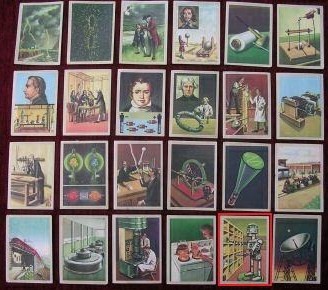
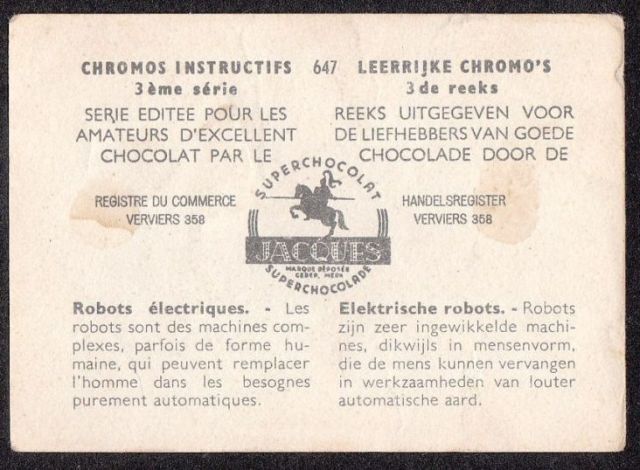
Garco even appeared on Belgian chocolate science-series cards in 1960.
Active service during 1958.
The Daily Courier
Feb. 20, 1958
"A robot will open the county science fair: GARCO is coming! That is the word received this morning by Mrs. Sarah Folsom, superintendent of county schools, who initiated plans for the first Science Fair to be held in Yavapai County. GARCO is now in southern California, but David Riordan, manager of public relations for Air Research, which created the mechanized man, has promised that the robot will be brought back to Arizona for the fair opening."
March 4, 1958
"A man with a six-cell brain will cut the ribbon when the first Science Fair in Yavapai County opens. He is GARCO, mechanical man designed by AiResearch Manufacturing Company, Phoenix, six years ago. The robot's mighty muscles are electro-actuators built to move aircraft and missile control surfaces."
March 28, 1958
"Working perfectly with oiled movements and smooth reactions, AiResearch's powerful mechanical man cut the ribbon and opened the first Yavapai County Science Fair at the Armory this morning. Operator of the robot is Don Hausman, engineering department of AiResearch. He sat behind GARCO at the controls. The fair is open today through 9 p.m. and Saturday from 9 a.m. until 4 p.m."
Update: December 2010
I see that Tom Carroll in SERVO magazine used my material on Garco as the basis for his article http://servo.texterity.com/servo/201010/?pg=75#pg75.
My intention is that my blog is to be used as a resource, so I'm glad to see its working.
Update: October 2012
Terry Chapman and Garco – where are you? Terry must be about 69 y/o about now.
Update: June 2013 – See comment below by Terry Chapman III.
Update: February 2015
Added two new video clips and new pics from Honeywell archive.
Gary Rollo from Torrance, where are you? Do you know where GARCO is?
See other early Humanoid Robots here.

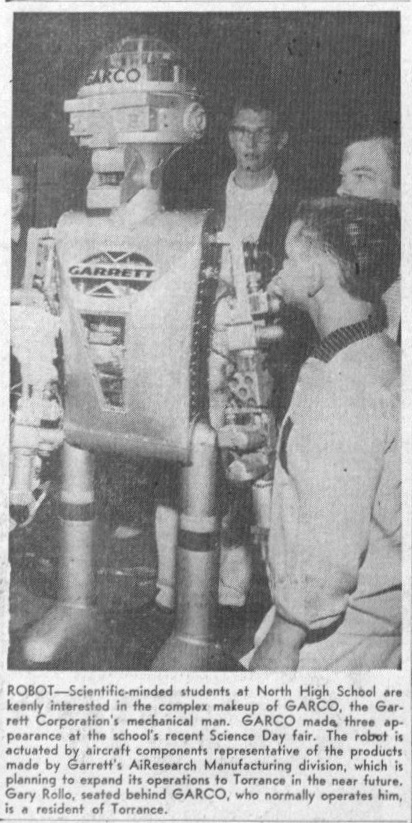
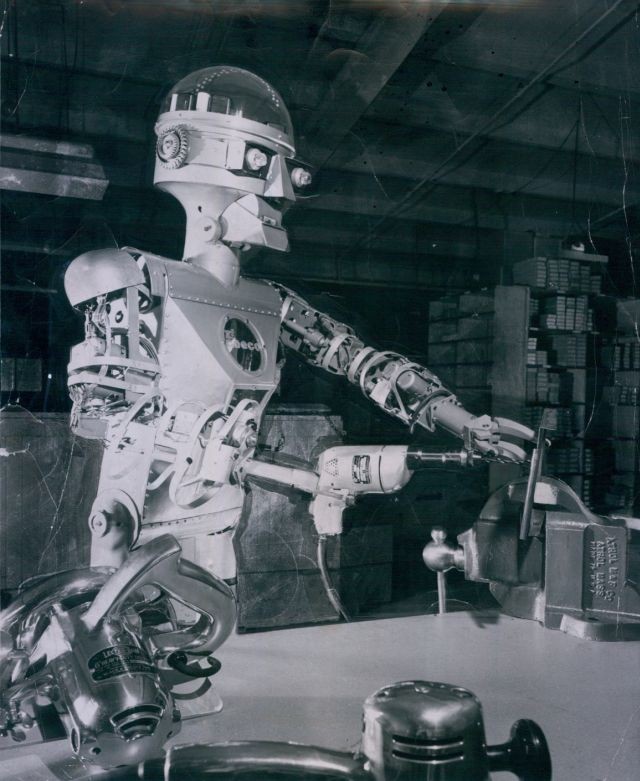
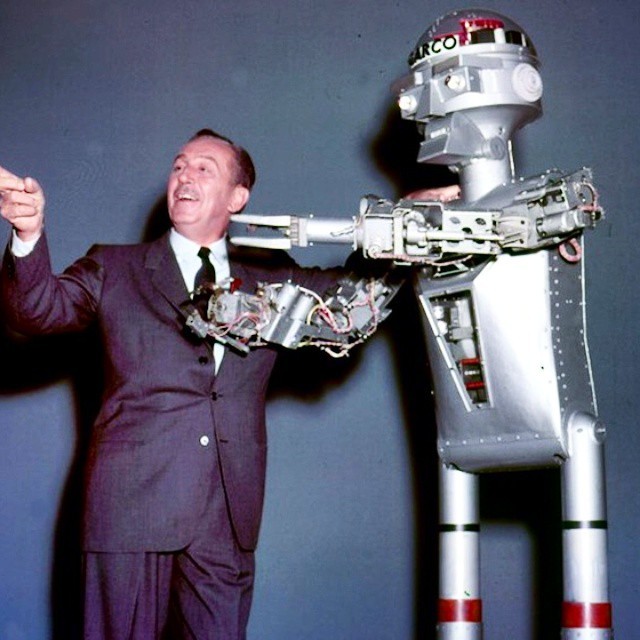

On this website, I see a photo of Garco, the robot, opening the Arizona State Fair in November 1957. It looks like a newspaper photo, but I thought I’d ask if its yours? I’m a member of a team documenting and restoring some of the buildings on the Fairgrounds. Thanks.
Jefferey – A set of the complete Science Fiction Theater got released this year. It includes the episode featuring GARCO, Time is Just a Place, as the second episode on the first Disc. I've only watched a little bit, but the video quality looks good for a 50's TV show (not as good as, say, the I Love Lucy releases, but better than the clip above).
Thanks Karl, Can’t mix up my Mansfield’s.
The woman you identify as Jane Mansfield in “Gog” is, in fact, Sally Mansfield. She played Vena Ray in the Rocky Jones serials.
aka: Terry Chapman ( 69 ) I don't know what ever happened to Garco.?? My father did not own "Garco", the Garrett Corp. did. He most probably went to Disney. i would also like to know. ?? Terry
This is truly an extraordinary and extensively researched blogspot webpage on Garco which made for most fascinating and informative reading to be sure.
I cannot find any personal background specifically on Harvey Chapman, Jr. pertaining to his birthdate and (presumed) date of passing but his incredible creation is certainly well documented.
As I have oft-timed expressed I sincerely hope that a quality DVD release of SCIENCE FICTION THEATRE (Syndicated 1955-57) will sometime in the near future see the light of day.